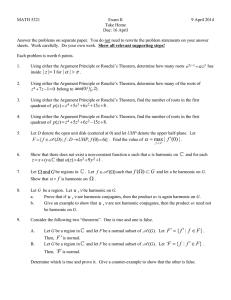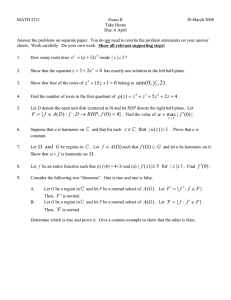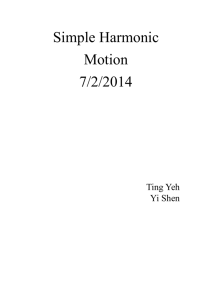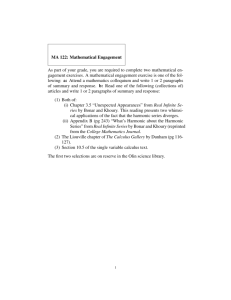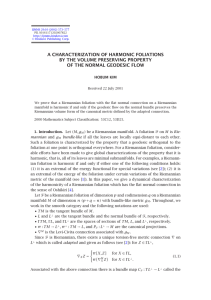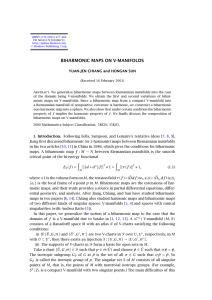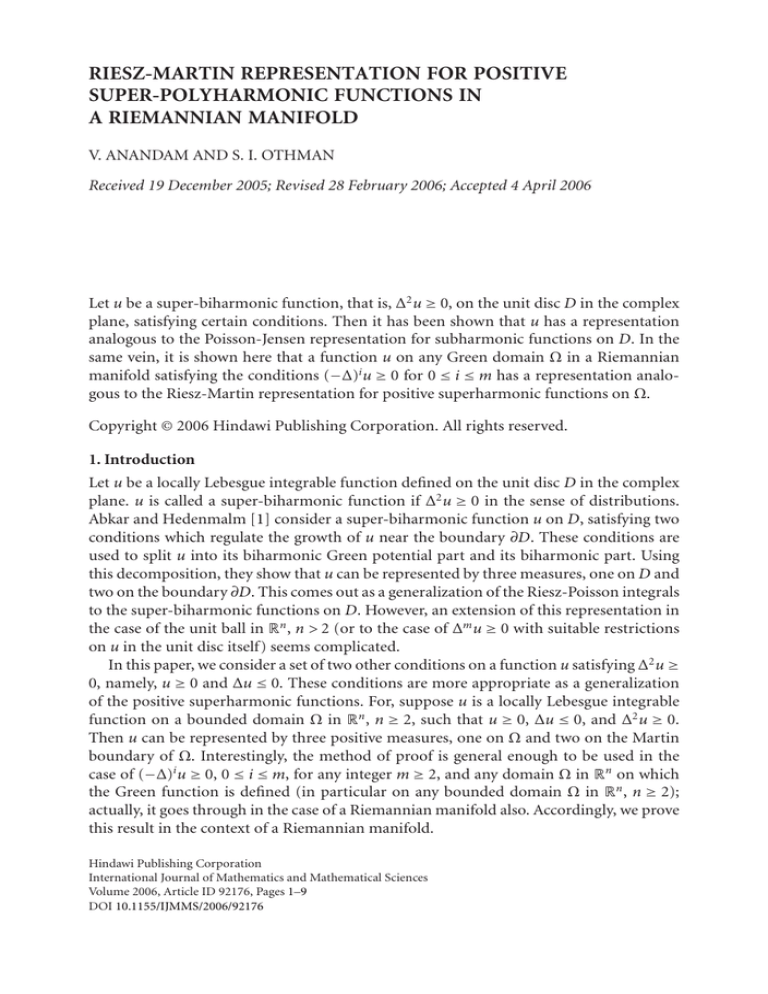
RIESZ-MARTIN REPRESENTATION FOR POSITIVE
SUPER-POLYHARMONIC FUNCTIONS IN
A RIEMANNIAN MANIFOLD
V. ANANDAM AND S. I. OTHMAN
Received 19 December 2005; Revised 28 February 2006; Accepted 4 April 2006
Let u be a super-biharmonic function, that is, Δ2 u ≥ 0, on the unit disc D in the complex
plane, satisfying certain conditions. Then it has been shown that u has a representation
analogous to the Poisson-Jensen representation for subharmonic functions on D. In the
same vein, it is shown here that a function u on any Green domain Ω in a Riemannian
manifold satisfying the conditions (−Δ)i u ≥ 0 for 0 ≤ i ≤ m has a representation analogous to the Riesz-Martin representation for positive superharmonic functions on Ω.
Copyright © 2006 Hindawi Publishing Corporation. All rights reserved.
1. Introduction
Let u be a locally Lebesgue integrable function defined on the unit disc D in the complex
plane. u is called a super-biharmonic function if Δ2 u ≥ 0 in the sense of distributions.
Abkar and Hedenmalm [1] consider a super-biharmonic function u on D, satisfying two
conditions which regulate the growth of u near the boundary ∂D. These conditions are
used to split u into its biharmonic Green potential part and its biharmonic part. Using
this decomposition, they show that u can be represented by three measures, one on D and
two on the boundary ∂D. This comes out as a generalization of the Riesz-Poisson integrals
to the super-biharmonic functions on D. However, an extension of this representation in
the case of the unit ball in Rn , n > 2 (or to the case of Δm u ≥ 0 with suitable restrictions
on u in the unit disc itself) seems complicated.
In this paper, we consider a set of two other conditions on a function u satisfying Δ2 u ≥
0, namely, u ≥ 0 and Δu ≤ 0. These conditions are more appropriate as a generalization
of the positive superharmonic functions. For, suppose u is a locally Lebesgue integrable
function on a bounded domain Ω in Rn , n ≥ 2, such that u ≥ 0, Δu ≤ 0, and Δ2 u ≥ 0.
Then u can be represented by three positive measures, one on Ω and two on the Martin
boundary of Ω. Interestingly, the method of proof is general enough to be used in the
case of (−Δ)i u ≥ 0, 0 ≤ i ≤ m, for any integer m ≥ 2, and any domain Ω in Rn on which
the Green function is defined (in particular on any bounded domain Ω in Rn , n ≥ 2);
actually, it goes through in the case of a Riemannian manifold also. Accordingly, we prove
this result in the context of a Riemannian manifold.
Hindawi Publishing Corporation
International Journal of Mathematics and Mathematical Sciences
Volume 2006, Article ID 92176, Pages 1–9
DOI 10.1155/IJMMS/2006/92176
2
Riesz-Martin representation
2. Preliminaries
Let R be an oriented Riemannian manifold of dimension ≥ 2, with local coordinates x =
(x1 ,...,xn ) and a C ∞ -metric
tensor gi j such that gi j xi x j is positive definite. Denote the
volume element by dx = det(gi j )dx1 ,...,dxn . Let Δ be the Laplace-Beltrami operator
which, acting on a C 2 -function f , gives Δ f = div grad f . However, we will assume that Δ
is taken in the sense of distributions. Thus, a locally dx-integrable function f on an open
set ω in R is said to be superharmonic (resp., harmonic) if Δ f ≤ 0 (resp., Δ f = 0) on ω;
a positive superharmonic function u on ω is called a potential if and only if the greatest
harmonic minorant of u on ω is 0, (i.e., if h is harmonic on ω and h ≤ u, then h should
be negative).
For each open set ω in R, let H(ω) denote the class of C 2 -functions u on ω such that
Δu = 0. If ω is a domain, H(ω) has the Harnack property, namely, if hn is an increasing sequence in H(ω) and if h = suphn , then h ∈ H(ω) or h ≡ ∞. We can also solve the
Dirichlet problem on any parametric ball. This means that the set of harmonic functions
H(ω) satisfies the axioms 1, 2, 3 of Brelot [7, pages 13-14]. Consequently, we can use the
results and the terminology of the Brelot axiomatic potential theory in the context of the
Riemannian manifold R.
A domain Ω in R is called a Green domain if the Green function G(x, y) is well defined
on Ω. On a Green domain Ω in R, we can construct the Martin compactification Ω of
Ω as in [8, pages 111–115]. Some of the important points to remember here are the
following: fix a point y0 in a Green domain Ω. If G(x, y) is the Green function on Ω, write
k y (x) = k(x, y) = G(x, y)/G(x, y0 ) with the convention k(y0 , y0 ) = 1. Then there exists
only one (metrizable) compactification Ω up to homeomorphism such that
(i) Ω is dense open in the compact space Ω;
(ii) k y (x), y ∈ Ω, extends as a continuous function of x on Ω;
(iii) the family of these extended continuous functions on Ω separates the points x ∈
Δ = Ω\Ω.
Ω is called the Martin compactification of Ω and Δ = Ω\Ω is called the Martin boundary. A positive harmonic function u > 0 is called minimal if and only if for any harmonic
function v, 0 ≤ v ≤ u, we should have v = αu for a constant α, 0 ≤ α ≤ 1. It can be proved
that every minimal harmonic function u(y) on Ω is of the form u(y0 )k(x, y) for some
x ∈ Δ, and the points x ∈ Δ corresponding to these minimal harmonic functions are
called the minimal points of Δ, and the set of minimal points of Δ is denoted by Δ1 ,
called the minimal boundary.
With these remarks, we can state the Martin representation theorem: for any harmonic
measure μ ≥ 0 on Δ with support in the
function u ≥ 0 on Ω, there exists a unique Radon
minimal boundary Δ1 ⊂ Δ such that u(y) = Δ1 k(x, y)dμ(x).
In the particular case of R = Rn , n ≥ 2, and Ω = B(0,1) the unit ball, taking the fixed
point y0 as the centre 0, we have the following: the Martin boundary Δ = Ω\Ω is homeomorphic to the unit sphere S and k(x, y) is the Poisson kernel; also Δ1 = Δ = S. Then the
Martin representation gives the familiar result (see, e.g., Axler et al. [4, page 105]): if u is
positive and harmonic on B, then there exists a unique positive Borel measure on S such
that u(x) = S p(x, y)dμ(y), where p(x, y), x ∈ B, y ∈ S, is the Poisson kernel.
V. Anandam and S. I. Othman 3
3. Riesz-Martin representation for positive super-biharmonic functions
Let Ω be a Green domain in a Riemannian manifold R, with the Green function G(x, y)
which is a symmetric function and for fixed y, G y (x) = G(x, y) is a potential on Ω; we
have also ΔG y (x) = −δ y (x), after a normalization.
Definition 3.1. A Green domain Ω in R called a biharmonic Green domain if for a pair
of points x and y in Ω, G2 (x, y) = Ω G(x,z)G(z, y)dz is finite. Then G2 (x, y) is called the
biharmonic Green function of Ω.
The above definition is given in Sario [10] when Ω = R, a hyperbolic manifold. On
an arbitrary hyperbolic Riemannian manifold R, the biharmonic Green function may
or may not exist. It is shown in [2, Theorem 3.2] that the biharmonic Green function
G2 (x, y) can be defined on a hyperbolic Riemannian manifold R if and only if there exist
two positive potentials p and q on R such that Δq = − p.
Consequently, any relatively compact domain Ω in a Riemannian manifold R is a
biharmonic Green domain, whether R is hyperbolic or parabolic. Note that if Ω is a
biharmonic Green domain in R, then u(x) = G2 (x, y) is a potential on Ω, for fixed y;
and Δu(x) = Δx G2y (x) = −G y (x) so that Δ2 u(x) = δ y (x).
then we know
Given a Radon measure μ ≥ 0 on Ω, if we set p(x) = Ω G(x, y)dμ(y),
that p ≡ ∞ or p(x) is a potential such that Δp = −μ. Let now q(x) = Ω G2 (x, y)dμ(y) be
finite at some point x0 ∈ Ω. Then,
∞>
Ω
Ω
G x0 ,z G(z, y)dz dμ(y) =
Ω
G x0 ,z
Ω
G(z, y)dμ(y) dz.
(3.1)
Hence p(z) = Ω G(z,y)dμ(y) ≡∞, so that p(z) is a potential on Ω, and q(x) = Ω G(x,z)p(z)dz,
which shows that q(x) is a potential on Ω and Δq(x) = − p(x) = − Ω G(x, y)dμ(y).
Let Ω be the Martin compactification of Ω, Δ = Ω\Ω the Martin boundary, and Δ1
the minimal boundary ⊂ Δ. Let k(x, y) be the Martin kernel, (x, y) ∈ Ω × Ω.
Notation
3.2. (1) Let π2 denote the set of positive Radon measures μ on Ω such that
q(x) = Ω G2 (x, y)dμ(y) is a potential on Ω.
(2) Let ∧0 denote the set of positive Radon measures v on Δ, with supp v ⊂ Δ1 .
(3)
that u(x) = Ω G(x,
Let ∧1 denote the positive Radon measures v ∈ ∧0 such
y)[ Δ1 k(X, y)dv(X)]d y is a potential on Ω. In that case, Δu(x) = − Δ1 k(X,x)dv(X) which
is harmonic, so that u(x) is also a biharmonic function on Ω. (Remark
that ∧1 can be
empty as in the case of Ω = Rn .) If v ∈∧1 , we will write k1 (X,x) = Ω G(x, y)k(X, y)d y
for X ∈ Δ1 , and x ∈ Ω, so that
u(x) = Ω G(x, y)[ Δ1 k(X, y)dv(X)]d y can be more elegantly represented as u(x) = Δ1 k1 (X,x)dv(X).
Lemma 3.3. Let μ ≥ 0 be a Radon measure on an open set ω in a Riemannian manifold
R, hyperbolic or parabolic. Then there exists a superharmonic function s on ω with μ as the
associated measure in a local Riesz representation.
Proof. The statement means that for every point x0 ∈ ω, there is a neighborhood δ,
x0 ∈ δ ⊂ δ ⊂ ω, with the Green function Gδ (x, y) such that s(x) = δ Gδ (x, y)dμ(y) +
(a harmonic function h(x)) in δ.
4
Riesz-Martin representation
For the construction of s in Rn , we refer to Brelot [6]. A similar method, with the use
of an approximation property given in Bagby and Blanchet [5, Theorem 3.10], proves the
result in a Riemannian manifold. (For a more general discussion of this result, see [3,
Section 2].)
By Definition 3.1, a Green domain Ω in a Riemannian manifold R (whether hyperbolic or parabolic) is a biharmonic Green domain if and only if G2 (x, y) ≡ ∞ on Ω. Note
that u(x) = G2y (x) > 0, Δu(x) = G y (x) < 0, and Δ2 u(x) = δ y (x) ≥ 0 on Ω. Hence on a biharmonic Green domain Ω, functions v of the type v > 0, Δv ≤ 0, and Δ2 v ≥ 0 exist. The
following theorem gives an integral representation for such functions.
Theorem 3.4. Let Ω be a biharmonic Green domain in a Riemannian manifold R (whether
R is hyperbolic or parabolic) and let v be a locally dx-integrable function on Ω. Then the
following are equivalent.
2
(a) v ≥ 0, Δv
≤20, and Δ v ≥ 0 on Ω.
(b) v(x) = Ω G (x, y)dμ(y) + Δ1 k1 (X,x)dv1 (X) + Δ1 k(X,x)dv0 (X) a.e. on Ω, where
(μ,v1 ,v0 ) ∈ π2 × ∧1 × ∧0 is uniquely determined.
Proof. (b)⇒(a). Let
u(x) =
2
Ω
G (x, y)dμ(y) +
Δ1
k1 (X,x)dv1 (X) +
Δ1
k(X,x)dv0 (X),
(3.2)
where μ ≥ 0 is a Radon measure on Ω, and v0 , v1 are positive Radon measures on Δ1 .
Ω by the assumption. Hence u ≡ ∞.
Then u(x) = v(x) a.e.
on
2 (x, y)dμ(y). Then u ≥ 0 is a potential on Ω, such that Δu (x) =
(i)
Let
u
(x)
=
G
1
1
1
Ω
− G(x, y)dμ(y) and Δ2 u1 = μ.
(ii) Let
u2 (x) =
Δ1
k1 (X,x)dv1 (X) =
Ω
G(x, y)
Δ1
k(X, y)dv1 (X) d y.
(3.3)
Then u2 ≥ 0 is a potential on Ω, such that Δu2 (x) = − Δ1 k(X,x)dv1 (X) = −h1 (x), where
function on Ω, so that Δu2 ≤ 0 and Δ2 u2 ≡ 0.
h1 (x) is a positive harmonic
(iii) Let u3 (x) = Δ1 k(X,x)dv0 (X).
Then u3 ≥ 0 is harmonic on Ω, so that Δu3 ≡ 0 and Δ2 u3 ≡ 0.
Consequently, u = u1 + u2 + u3 ≥ 0 on Ω such that Δu ≤ 0 and Δ2 u ≥ 0 on Ω. Since
u = v a.e., the statement (a) is proved.
(a)⇒(b). Since Δ2 v ≥ 0, Δ2 v = μ, where μ is a positive Radon measure on Ω. Since
Δ(Δv) = μ, Δv is a subharmonic function on Ω. Since Δv ≤ 0 by hypothesis, −Δv is a
positive superharmonic function on Ω. Hence by the Riesz representation theorem,
−Δv(x) =
Ω
G(x, y)dμ(y) + h(x),
where h(x) is a positive harmonic function on Ω.
(3.4)
V. Anandam and S. I. Othman 5
Let us choose (using the lemma above) two superharmonic functions q(x) and H(x)
on Ω such that
Δq(x) = −
Ω
G(x, y)dμ(y),
(3.5)
ΔH(x) = −h(x).
Then from (3.4),
v(x) = q(x) + H(x) + a harmonic function h1
on Ω.
(3.6)
Since v ≥ 0 on Ω, q(x) ≥ −H(x) − h1 (x); that is, q(x) has a subharmonic minorant on Ω.
Hence q(x) has the greatest harmonic minorant h2 (x) on Ω, and by the Riesz representation theorem,
q(x) =
=
=
Ω
Ω
Ω
G(x, y) − Δq(y) d y + h2 (x) on Ω
G(x,z)
Ω
G(z, y)dμ(y) dz + h2 (x)
(3.7)
G2 (x, y)dμ(y) + h2 (x).
Similarly, dealing with the superharmonic function H(x) and its greatest harmonic
minorant h3 (x) on Ω, we can write
H(x) =
Ω
G(x, y) − ΔH(y) d y + h3 (x) on Ω
=
Ω
G(x, y)h(y)d y + h3 (x)
=
Ω
G(x, y)
(3.8)
Δ1
k(X, y)dv1 (X) d y + h3 (x),
by using the Martin representation for the positive harmonic function h on Ω. Note that
v1 ∈ ∧1 and is uniquely determined. Consequently,
H(x) =
Δ1
k1 (X,x)dv1 (X) + h3 (x).
(3.9)
Now, using (3.6), (3.7), and (3.9), we write
v(x) =
Ω
G2 (x, y)dμ(y) +
Δ1
k1 (X,x)dv1 (X) + h0 (x),
(3.10)
where h0 = h1 + h2 + h3 is harmonic on Ω.
Now by hypothesis v ≥ 0, so that
−h0 (x) ≤
Ω
G2 (x, y)dμ(y) +
Δ1
k1 (X,x)dv1 (X) on Ω.
(3.11)
6
Riesz-Martin representation
Now the two terms on the right side are potentials on Ω and hence their sum also is a
potential on Ω. This means that the harmonic function −h0 is majorized by a potential
on Ω, so that −h0 ≤ 0. Thus h0 is a positive harmonic function Ω. Use the Martin representation to conclude that there exists a unique measure v0 on the Martin boundary with
support in Δ1 , such that
h0 (x) =
Δ1
k(X,x)dv0 (X).
(3.12)
Thus, from (3.10) and (3.12), we finally arrive at the representation for v(x) on Ω:
v(x) =
Ω
G2 (x, y)dμ(y) +
Δ1
k1 (X,x)dv1 (X) +
Δ1
k(X,x)dv0 (X),
(3.13)
where (μ,v1 ,v0 ) ∈ π2 × ∧1 × ∧0 is uniquely determined.
4. Representation for positive super-polyharmonic functions
By induction, we can extend Theorem 3.4 to obtain the Riesz-Martin representation for
positive super-polyharmonic functions.
Let Ω be a Green domain in a Riemannian manifold R, with G(x, y) as the Green
function of Ω. For an integer m ≥ 2, we will denote
Gm (x, y) = G x,zm−1 G zm−1 ,zm−2 · · · G z1 , y dz1 · · · dzm−1
(4.1)
and say that a positive Radon measure μ on Ω is in πm if u(x) = Ω Gm (x, y)dμ(y) ≡ ∞ on
Ω, in which case u(x) is a potential on Ω and (−Δ)m u = μ; also (−Δ) j u ≥ 0 for 0 ≤ j ≤ m.
When such a function u(x) exists on Ω, we say that Ω is an m-harmonic Green domain
in R, whether R is hyperbolic or parabolic.
Let Ω be the Martin compactification of Ω and let k(x, y) be the Martin kernel. For
any i, 1 ≤ i ≤ m − 1, let ∧i denote the set of positive Radon measures vi on Δ = Ω\Ω with
support in the minimal boundary Δ1 , such that
vi (x) = G x,zi G zi ,zi−1 · · · G z2 ,z1
Δ1
k X,z1 dv(X) dz1 · · · dzi ≡ ∞.
(4.2)
In that case, vi (x) is a potential on Ω, (−Δ)i vi ≡ 0; also (−Δ) j vi ≥ 0 for 0 ≤ j ≤ i. Let
us write for X ∈ Δ1 and x ∈ Ω,
ki (X, y) = G x,zi · · · G z2 ,z1 k X,z1 dz1 · · · dzi .
(4.3)
Then, if v ∈ ∧i , vi (x) = Δ1 ki (X,x)dv(X) is well defined on Ω with the above properties.
As before, let ∧0 denote the set of positive Radon measures v on Δ, with support in Δ1 .
Then, the proof of Theorem 3.4 can be extended by using the method of induction to
arrive at the following result.
Theorem 4.1. Let Ω be an m-harmonic Green domain in a Riemannian manifold R and
let v be a locally dx-integrable function on Ω. Let m ≥ 1 be an integer. Then the following
V. Anandam and S. I. Othman 7
are equivalent.
(a) (−Δ)i v ≥ 0 on Ω for 0 ≤ i ≤ m.
(b) There exist unique measures μ ∈ πm and vi ∈ ∧i for 0 ≤ i ≤ m − 1 such that
v(x) =
Ω
Gm (x, y)dμ(y) +
m
−1 i=0
Δ1
ki (X,x)dvi (X) a.e. on Ω.
(4.4)
5. Integral representations in a Riemann surface
We are not in a position to say that the above integral representation theorems in a
Riemannian manifold R are automatically valid in a Riemann surface S. For, we have used
the Laplace-Beltrami operator Δ on R to define polyharmonic-superharmonic functions
on R and also to obtain some of their properties. But the Laplacian is not invariant under a parametric change in an abstract Riemann surface S. Hence there is a problem. We
indicate in this section how to get over this difficulty.
Let S be a Riemann surface. Let μ ≥ 0 be a Radon measure defined on an open set ω
in S. Then, using an approximation theorem of Pfluger [9, page 192], we can show that
there exists a superhamonic function s on ω with associated measure μ in a local Riesz
representation as explained in Lemma 3.3 (see [3, Theorem 2.3]). Let us symbolically
denote this relation between s and μ by Ls = −μ on ω.
Let now dσ denote the surface measure on S. Then, given any locally dσ-integrable
function f on an open set ω, let λ be the signed measure on ω defined by dλ = f dσ.
Construct as above two superharmonic functions s1 and s2 on ω, such that Ls1 = −λ+ and
Ls2 = −λ− . Let us denote this relation between the δ-superharmonic function s = s1 − s2
and the locally dσ-integrable function f by Ls = − f .
We will say that s = (sm ,sm−1 ,... ,s1 ) is a polyharmonic-superharmonic function of order m in an open set ω, if s1 is superharmonic on ω and Lsi = −si−1 for 2 ≤ i ≤ m. We
will say that s ≥ 0 if each si ≥ 0. If there exists a polyharmonic-superharmonic function
s = (sm ,sm−1 ,...,s1 ) ≥ 0, si ≡ 0 for any i, on a domain Ω in S, we say that Ω is an mharmonic Green domain in S.
Let now Ω be a Green domain in a Riemann surface S. As before, let Ω be the Martin
compactfication of Ω, let Δ = Ω\Ω be the Martin boundary, and let Δ1 be the minimal
boundary. Then, with the notations as in Section 4, we can prove the following.
Theorem 5.1. Let Ω be an m-harmonic Green domain in a Riemann surface S. Let m ≥ 1
be an integer. Then, the following are equivalent.
(a) s = (sm ,sm−1 ,...,s1 ) ≥ 0 is a polyharmonic-superharmonic function of order m in
Ω.
(b) For any j, 1 ≤ j ≤ m, there exist unique measures μ ∈ π j and vi ∈ ∧i for 0 ≤ i ≤
j − 1 such that
s j (x) =
Ω
G j (x, y)dμ(y) +
j −1 i=0 Δ1
ki (X,x)dvi (X)
(c) The above property (b) is satisfied for j = m.
a.e. on Ω.
(5.1)
8
Riesz-Martin representation
Proof. (a)⇒(b). Fix j, 1 ≤ j ≤ m. Then (s j ,s j −1 ,...,s1 ) is a j-superharmonic function on
Ω, since (−L)si+1 = si for 1 ≤ i ≤ j − 1 and s1 is superharmonic. Moreover, since (−L)si+1
≥ 0, each si is a positive superharmonic function. Write s1 = p1 + h1 as the unique sum of
a potential p1 and a positive harmonic function h1 . Let (−L)p1∗ = p1 and (−L)h∗1 = h1 .
Then p1∗ and h∗1 are superharmonic on Ω and
(−L)s2 = p1 + h1 = (−L)p1∗ + (−L)h∗1 .
(5.2)
That is, s2 = p1∗ + h∗1 + (a harmonic function) on Ω. Since s2 ≥ 0, p1∗ has a subharmonic
minorant on Ω and hence p1∗ = (a potential p2 ) + (the greatest harmonic minorant of
p1∗ , which may not necessarily be positive).
Then s2 = p2 + u2 , where u2 is superharmonic on Ω. Since s2 ≥ 0, p2 ≥ −u2 . Since p2 is
a potential and −u2 is subharmonic, −u2 ≤ 0. Hence s2 = p2 + u2 , where p2 is a potential
on Ω such that (−L)p2 = p1 and u2 ≥ 0 is superharmonic such that (−L)u2 = h1 .
Thus proceeding, we can write
s j ,...,s2 ,s1 = p j ,..., p2 , p1 + u j ,...,u2 ,h1 ,
(5.3)
where (−L)pi+1 = pi for 1 ≤ i ≤ j − 1, and p1 ,..., p j are all potentials; (−L)ui+1 = ui for
2 ≤ i ≤ j − 1 and (−L)u2 = h1 .
Now take (u j ,...,u2 ,h1 ) and proceed as before. Note now h1 is positive harmonic, so
that we can write
u j ,...,u2 ,h1 = q j ,..., q2 ,h1 + f j ,..., f3 ,h2 ,0 ,
(5.4)
where (−L)qi+1 = qi for 2 ≤ i ≤ j − 1, (−L)q2 = h1 , and each qi is a potential; (−L) fi+1 =
fi ≥ 0 for 3 ≤ i ≤ j − 1, (−L) f3 = h2 , and (−L)h2 = 0, so that h2 is positive harmonic.
Then take ( f j ,..., f3 ,h2 ,0) and follow the same procedure, so that
f j ,..., f3 ,h2 ,0 = r j ,...,r3 ,h2 ,0 + g j ,...,g4 ,h3 ,0,0 ,
(5.5)
where (−L)ri+1 = ri for 3 ≤ i ≤ j − 1, (−L)r3 = h2 and each ri is a potential; (−L)gi+1 =
gi ≥ 0 for 4 ≤ i ≤ j − 1, (−L)g4 = h3 and (−L)h3 = 0, so that h3 is harmonic ≥ 0.
Thus proceeding, we finally arrive at the decomposition
s j ,...,s1 = p j ,..., p1 + q j ,..., q2 ,h1 + r j ,...,r3 ,h2 ,0 + · · · + h j ,0,...,0 .
(5.6)
Let (−L)p1 = μ; let vi (1 ≤ i ≤ j) be the positive Radon measure on Δ with support in Δ1 ,
associated with the positive harmonic function hi in the Martin representation.
Then s j = p j + q j + r j + · · · + h j has the integral representation
s j (x) =
Ω
G j (x, y)dμ(y) +
(b)⇒(c). j = m is a particular case of (b).
j −1 i=0 Δ1
ki (X,x)dvi (X) a.e. on Ω.
(5.7)
V. Anandam and S. I. Othman 9
(c)⇒(a). By the assumption,
sm (x) =
Ω
Gm (x, y)dμ(y) +
m
−1 i=0
Δ1
ki (X, y)dvi (X) a.e.
(5.8)
Hence we can express sm in the form sm (x) = pm (x) + mj =−01 q j (x). We can calculate to
find that (−L)i pm is a potential for 1 ≤ i ≤ m − 1 and (−L)m pm = μ, a positive Radon
measure; and (−L)i q j is a potential for 1 ≤ i ≤ j − 1 and (−L) j q j = 0.
Write now (−L)sm = sm−1 , (−L)sm−1 = sm−2 ,..., (−L)s2 = s1 . We can see that each si
(1 ≤ i ≤ m) is a positive superharmonic function and (−L)si+1 = si for 1 ≤ i ≤ m − 1.
Hence s = (sm ,sm−1 ,... ,s1 ) ≥ 0 is a polyharmonic-superharmonic function of order m.
References
[1] A. Abkar and H. Hedenmalm, A Riesz representation formula for super-biharmonic functions,
Annales Academiæ Scientiarium Fennicæ Mathematica 26 (2001), no. 2, 305–324.
[2] V. Anandam, Biharmonic Green functions in a Riemannian manifold, Arab Journal of Mathematical Sciences 4 (1998), no. 1, 39–45.
, Biharmonic classification of harmonic spaces, Revue Roumaine de Mathématiques Pures
[3]
et Appliquées 45 (2000), no. 3, 383–395.
[4] S. Axler, P. Bourdon, and W. Ramey, Harmonic Function Theory, Graduate Texts in Mathematics,
vol. 137, Springer, New York, 1992.
[5] T. Bagby and P. Blanchet, Uniform harmonic approximation on Riemannian manifolds, Journal
d’Analyse Mathématique 62 (1994), 47–76.
[6] M. Brelot, Fonctions sousharmoniques associées à une mesure, Studii şi Cercetari Matematice, Iaşi,
Academiei Române, Section Jasy, Roumania 2 (1951), 114–118.
, Axiomatique des fonctions harmoniques, Les Presses de l’Université de Montréal,
[7]
Montréal, 1966.
, On Topologies and Boundaries in Potential Theory, Lecture Notes in Mathematics, vol.
[8]
175, Springer, Berlin, 1971.
[9] A. Pfluger, Theorie der Riemannschen Flächen, Springer, Berlin, 1957.
[10] L. Sario, A criterion for the existence of biharmonic Green’s functions, Journal of the Australian
Mathematical Society, Series A 21 (1976), no. 2, 155–165.
V. Anandam: Department of Mathematics, King Saud University, P.O. Box 2455,
Riyadh 11451, Saudi Arabia
E-mail address: vanandam@ksu.edu.sa
S. I. Othman: Department of Mathematics, King Saud University, P.O. Box 2455,
Riyadh 11451, Saudi Arabia
E-mail address: sadoon@ksu.edu.sa


